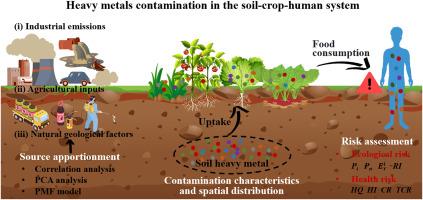长三角典型高地质背景区土壤-作物-人体系统重金属及类金属污染特征、来源分析及风险评价
IF 8.4
2区 环境科学与生态学
Q1 ENVIRONMENTAL SCIENCES
引用次数: 0
摘要
浙江省安吉县是长三角内典型的高地质背景地区。本研究旨在通过对土壤-作物-人系统的综合探索,弥补传统重金属和类金属研究的碎片化空白。表层土壤8种重金属和类金属(As、Hg、Cr、Cu、Pb、Zn、Ni、Cd)均超过背景值,特别是Cd(3.75倍),其空间分布与黑色岩系相关。利用Spearman相关分析、主成分分析(PCA)和正矩阵分解(PMF)模型确定污染源:工业污染(25.76%)、交通污染(23.16%)、农业污染(16.94%)、混合污染(15.55%)和岩性污染(18.60%)。利用Nemerow综合污染指数(Pn)和潜在生态风险指数(RI)进行生态风险评价表明,Cd的单一污染指数为2.32,带动Pn达到1.77,为轻度污染,对RI的贡献率为97.11%。在种植系统中,旱地重金属含量高于水田和茶田,作物水平为蔬菜和蔬菜;茶比;大米。植物积累异质性显著。叶菜对重金属的积累能力较强。饮食差异导致不同的风险易感性。有限的茶摄入量降低了儿童的致癌风险(CR),而增加的山核桃摄入量则增加了其风险。尽管土壤-作物系统受到污染,但人口健康指标未显示出显著的负面影响。生物监测显示尿镉超标与正常的头发镉水平相反,提示有效的肾脏清除机制抵消了环境暴露,尽管长期风险需要继续监测。这些发现为高本底地区重金属污染对人体健康的影响提供了新的见解。本文章由计算机程序翻译,如有差异,请以英文原文为准。

Contamination characteristics, source apportionment, and risk assessment of heavy metals and metalloids in the soil-crop-human system within the typical high geological background region of the Yangtze River Delta
Anji County, Zhejiang Province, is a typical high geological background region within the Yangtze River Delta. Our study aimed to address gaps in fragmented traditional heavy metal and metalloid research by comprehensively exploring the soil-crop-human system. In surface soil, all eight heavy metals and metalloids (As, Hg, Cr, Cu, Pb, Zn, Ni, and Cd) exceeded the background values, especially Cd (3.75 times), and their spatial distribution correlated with the black rock series. Spearman correlation analysis, principal component analysis (PCA), and positive matrix factorization (PMF) models were utilized to identify sources: industrial (25.76 %), traffic (23.16 %), agricultural (16.94 %), mixed (15.55 %), and lithogenic (18.60 %). Ecological risk assessment with Nemerow's synthetical pollution index (Pn) and potential ecological risk index (RI) showed that Cd had a single pollution index of 2.32, which drove Pn to 1.77, signifying mild pollution, and contributed 97.11 % to RI. In the planting system, dry land enriched more heavy metals than paddy and tea fields, and crop levels were vegetables > tea > rice. Phytoaccumulation heterogeneity was pronounced. Leafy vegetables exhibited a relatively strong accumulation ability for heavy metals. Dietary differences drove divergent risk susceptibilities. Limited tea consumption reduced children's carcinogenic risk (CR), whereas increased hickory intake amplified their risk. Despite the contamination of the soil-crop system, population health indicators did not show significant negative effects. Biomonitoring revealed urinary Cd exceedance against normative hair Cd levels, suggesting effective renal clearance mechanisms counteracting environmental exposure, albeit long-term risks necessitate continued monitoring. These findings provide new insights into the impact of heavy metal pollution on human health in high-background areas.
求助全文
通过发布文献求助,成功后即可免费获取论文全文。
去求助
来源期刊

Journal of Environmental Management
环境科学-环境科学
CiteScore
13.70
自引率
5.70%
发文量
2477
审稿时长
84 days
期刊介绍:
The Journal of Environmental Management is a journal for the publication of peer reviewed, original research for all aspects of management and the managed use of the environment, both natural and man-made.Critical review articles are also welcome; submission of these is strongly encouraged.
 求助内容:
求助内容: 应助结果提醒方式:
应助结果提醒方式:


